Note that most of this region's job creation falls between $5.50 to about $7.50. Most of VCEDA's "job creation" isn't producing middle-class jobs. I'm in the process of trying to get VCEDA and other local agencies to produce a "list" of jobs they have created with wage-scales and what education levels, but so far have been refused. This (less than $8 an hour) is what I'll refer to as "poverty wages" due to the fact nobody can support a family on them due to the high cost of living here.
From what I've seen with VCEDA and other government agencies in this area, they are marketing cheap labor and generous corporate welfare including free infrastructure, job training, and tax breaks. We should demand more than just $6 an hour.
Related issues:
- What ING Says About Tri-Cities
- The Truth about Unemployment
- Nepotism an issue in county, city government in Tennessee and Virginia
- Income Gap Grows in Virginia 4/10/02
- Income gap grows again
- Why Telecom is No Future
Their service area includes the counties of Buchanan, Dickinson, Lee, Scott, Wise, Russell, Tazewell, and the City of Norton. City of Bristol, Washington County borders them and that is where I live. Other than no mining and more manufacturing along I-81 in Bristol and Washington Counties, the trends are the same towards a low-wage poverty work force in an economy dependant on government spending and transfer payments.
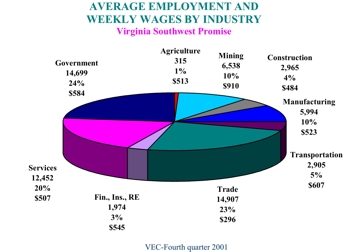
The above chart prompted me to go to the Virginia Employment Commission (VEC) in Bristol, VA and research this. I got copies of the stats for Buchanan County in the coalfields (VCEDA's service area) versus Bristol, VA and Washington County along I-81. What I found was a shock. Before I get to that, let's clarify the above hard-to-read pie chart and the problems with it. I'll be looking at government, trades, services, mining, and manufacturing which covers almost 90% of the workforce.
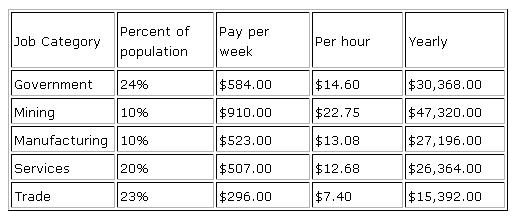
It should be obvious we have two glaring contradictions between this table and VCEDA's own poll above in services and manufacturing. When I pulled the paperwork at VEC, I was informed the stats were "voluntary" from employers and "not verified" by VEC. It's also incomplete with certain things listed with a "D" for disclosure suppression. The problem is the data itself is distorted for the following reasons:
- They lumped professionals like doctors, etc. in with hotel clerks under services. The gross wage gap inflated the overall earnings on paper. With about one-fifth of services being professionals, that left about 80% earning around $6 an hour including those engaged in home health care the big growth sector in medical. Services should be reduced to 16% of the population and about $6 an hour or about $12,480 per year. This is one example how the government uses "averages" to hide wage-gaps and general poverty.
- In manufacturing it's just plain nonsense. I know of few manufacturers in southwest Virginia that pays an average of $13.08 an hour except perhaps mining machinery, which has all but closed down. In Bristol and Washington County, it averages between $6 and $9 an hour. The average from VCEDA's poll above matches my poll. Let's say an average of $7.50 in the Bristol area. Trades is also inflated, I'll go with VCEDA and say about $6 an hour for an average. Manufacturing has been hammered in the region due to NAFTA with over 2500 jobs lost in Smyth County (next door to Washington) alone.
- Mining and government looks correct overall. In Bristol and Tri-Cities we have no mining and manufacturing is between 20% and 30%.
Note that I'm basing everything on a 40-hour week, 52 weeks per year. I've also excluded ambulatory health care, which caused a huge income spike in services for Washington County but doesn't exist in Bristol. This is due to the Bristol hospital being in the Tennessee side of town. Let's look at a revised chart for based on VEC stats for Bristol and Washington County, March 31, 2002:
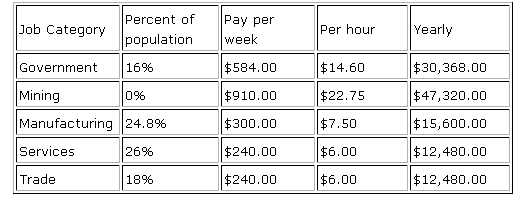
Note that Bristol and Washington County have a large percentage of non-profits that in reality work for the government receiving tax dollars aren't included under government. And another table for Bristol:
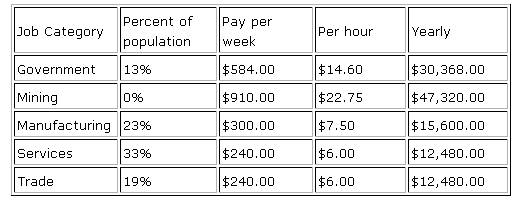
This data from the employment commission reinforces the above:
In the last 10 years, we have lost 1,059 people in Bristol Virginia. In the past 40 years, we have gained 223 in population. We are a small community of about 17,400. Two-thirds of the households have a combined income of less than $30,000; 5.6 percent have combined income of $60,000 or more.
That's why our residents are often forced to work 2-3 jobs just to survive. The real winners here are three groups one of them not mentioned: Government employees get the good jobs and benefits unlike much of the private sector employment. Professionals do real well as do those that still have jobs in mining which continues to decline. Move-in retirees make far more than the average private-sector worker. Transfer payments are the biggest single source of income in Bristol and government spending is what floats the economy of Southwest Virginia.
Note that what I did above is based on incomplete information and will vary from county to county. The conclusion is those that work for government get the good jobs, while those without connections are out of luck.
One final point in regards to the Coalfields Expressway they want to build in Dickinson and Buchanan counties at a cost of $1.6 billion: It will make no difference in employment in regards to wage-scales. Because the only jobs generated outside government along US 23 in Scott and Wise Counties and US 19 in Washington and Russell Counties is trades and services, low pay is still be the order of the day. With continued declines in manufacturing, I-81 is much the same and isn't bringing decent jobs in either, just poverty-wage tourist, retirement, and retail jobs. It will be no different with another new road.
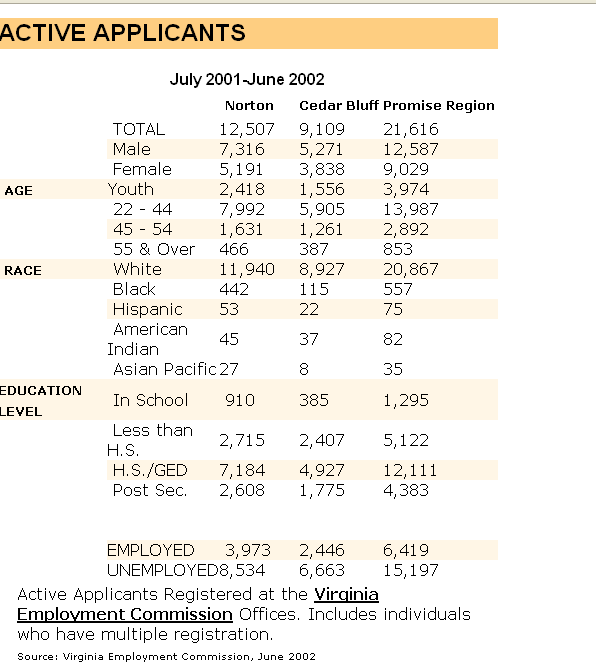
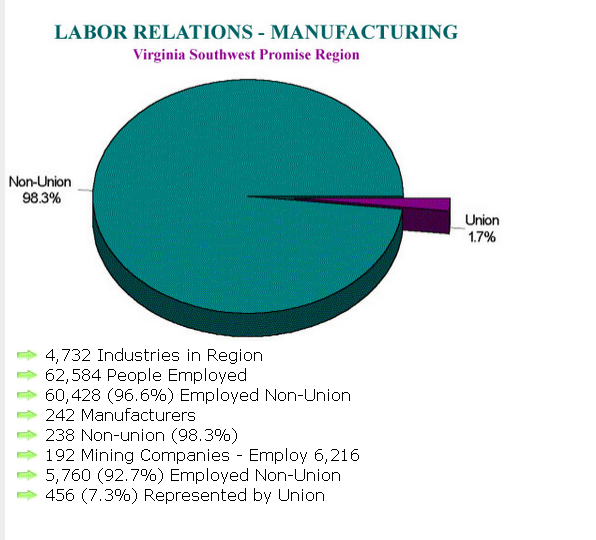
The Virginia Employment Commission provides you with easy access to information about job opportunities, unemployment insurance, and the labor market in the Commonwealth of Virginia.
VEC Mission- We meet our customers' needs by providing employment services, labor market information, and unemployment insurance to promote job opportunities and economic growth in Virginia.
VEC Local Offices- The VEC provides a wide range of services in more than 40 offices across the state. To obtain assistance or more information, please contact us through E-mail at mailto:vec@vaworkforce.com. You also may call (804) 786-1485 or TDD (804) 371-8050.The mailing address is Virginia Employment Commission, P.O. Box 1358, Richmond Virginia 23218-1358.
Training Programs
Since 1965, Workforce Services has offered consulting services and training assistance to new and expanding businesses in Virginia. To be eligible, a company must create 25 or more new jobs within a one-year period and make a capital investment of at least $1,000,000.
The Promise region is served by two community colleges, Mountain Empire Community College in Big Stone Gap, VA, and Southwest Virginia Community College in Richlands, VA. Both institutions are committed to training and retraining of the regions workforce. They stand ready to work with new and expanding industry on any type of training to meet their workforce requirements.
Workforce Services offers companies assistance in recruiting prospective trainees, providing specialists who analyze job-training requirements, developing and implementing training programs, conducting "Train-the-Trainer" programs, developing training materials, and arranging for training facilities. Workforce Services also offers assistance in implementing concepts such as self-directed work teams, continuous improvement and quality assurance.
Unemployment Insurance Tax
Virginia also enjoys a very low tax burden from Unemployment Compensation taxes. At .1%, it's more than 66% lower than the national average.
Note that VA just required all employers to start paying unemployment insurance. A program that let those without constant lay-offs slide has ended I'm guessing due to severe budget problems in the state. Source: Virginia Economic Development Partnership
"Economic developers like to point out that Virginia is the northernmost right-to-work state, which means it can offer a stable labor force in a location that's easily accessible to population centers in the East and Midwest." Business Facilities magazine, May 1997 issue
Workers' Compensation for Manufacturers - Average is $1.83 per $100 of payroll for January 1, 2002, more than 40% lower than the national average. Source: Virginia Economic Development Partnership
Crossroads Rural Entrepreneurial Institute
The Crossroads Rural Entrepreneurial Institute, potentially located in an empty Lowe's building in Galax, VA, will help improve the lives of people in southwest Virginia and beyond by providing an innovative educational/economic development engine that will contribute to the revitalization of the region's economy and offer a brighter future for its citizens.
Through a unique partnership among educational institutions; economic developers; and local, state, and federal government, the Crossroads Rural Entrepreneurial Institute will consist of three centers: 1) mixed-use business incubator facility including business assistance and consultants; 2) technology-enhanced educational center including web-based programs for high school students, an economic development magnet school, high-demand technical and occupational programs for high school and college students, transfer programs, and a university center; 3) continuing education center for workforce skills including literacy, GED, workforce and corporate training, and a convention center/exhibition hall. The three centers will work together, in the same space, under the auspices of the Institute to meet the demands of changing economic environments and help bolster the region's depressed economy.
The Need
Southwest Virginia has recently experienced tremendous economic crisis. Within the last five years, the region has lost 2,500 jobs. More than 2,000 jobs in textile factories, once the largest source of employment have been lost, and other historically strong industries such as manufacturing and agriculture have experienced a loss of 500 jobs. Unemployment in this area is frequently among the highest in Virginia, with Grayson County having the single highest unemployment rate of any county in early 2001. More recently, Wythe County reported unemployment rates of 9.4%--three times the state average. Additionally, 35% of the existing workforce are underemployed. Further combined evidence:
2,500 jobs lost to overseas competition and a declining agriculture industry
Record unemployment (Grayson County had the highest rate in the state in early 2001 and Wythe County recently reported unemployment rates of 9.4%)
35% of the existing workforce is underemployed
Economic Development Administration of the U.S. Department of Commerce has designated the localities in the Wytheville Community College service region as "Economically Distressed Rural Communities" due to job losses and high unemployment.
Region has been designated a "NAFTA Distressed Community" by the Community Adjustment Investment Program
28.4% of the region's population live at or below the 150% poverty level according to the Virginia Statistical Abstract, 2000 Edition, Charlottesville, VA: University of Virginia.
- Fear and Loathing of Islam is not Islamophobia
- Scientific Case for a Transcendent God
- In Defense of Classical Deism
- Environmentalism is Still a Religion
- Let Racist Leonard Pitts Eat Cake
- Obama's Science Teacher Training Initiative Politicized Science
- Democrats Disdain of Voters Hides Religious Crusade
- Humanist Violence Fails to Suppress Theism
- Failure of Marxism as Humanism in Practice
- No US Job Creation in 15 Years
- California and its Illegal Alien Migrant Children
- Predominant Face of American Poor is White
- Intellectuals and Racial Socialism
- Leftists, Progressives and Socialists
- Immigrants And Hipsters Attack Tech Workers
- Why Is The Republican Party Embracing Amnesty?
- Racial Stupidity and Malevolence
